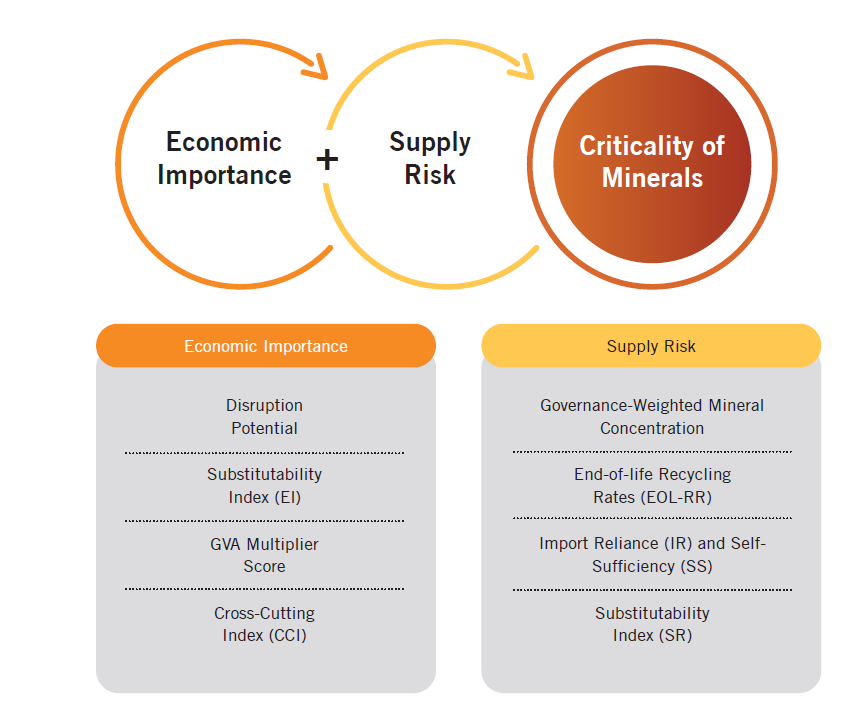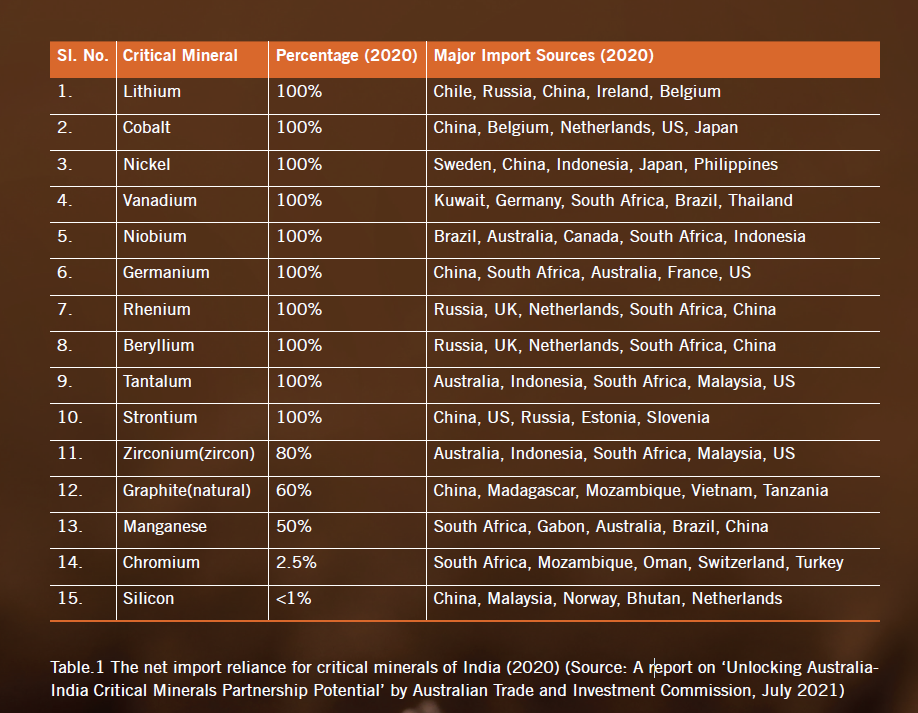Governance
Critical Minerals for India
- 30 Jun 2023
- 7 min read
For Prelims: Critical Minerals, Net Zero' Emission Target, Electric vehicles, Renewable energy, Mineral Security Partnership.
For Mains: Significance of Critical Minearls for India, Mineral Distribution in India
Why in News?
The Ministry of Mines, Government of India recently unveiled the first-ever report on "Critical Minerals for India" prepared by an expert team constituted by the Ministry of Mines.
- The report identifies and prioritizes minerals essential for various industrial sectors, aligning with India's vision of achieving a robust and resilient mineral sector in line with the larger goal of attaining 'Net Zero' emissions.
What are Critical Minerals?
- Minerals:
- Minerals are natural substances that are formed by geological processes. They have a definite chemical composition and physical properties.
- They are classified into metallic and non-metallic minerals based on their characteristics and uses.
- Metallic minerals are those that contain metals or metal compounds, such as iron, copper, gold, silver, etc.
- Non-metallic minerals are those that do not contain metals, such as limestone, coal, mica, gypsum, etc.
- Critical Minerals:
- Critical minerals are those minerals that are essential for economic development and national security, the lack of availability of these minerals or concentration of extraction or processing in a few geographical locations may lead to supply chain vulnerabilities and even disruption of supplies.
- Declaration of Critical Minerals:
- It is a dynamic process, and it can evolve over time as new technologies, market dynamics, and geopolitical considerations emerge.
- Different countries may have their own unique lists of critical minerals based on their specific circumstances and priorities.
- The US has declared 50 minerals critical in light of their role in national security or economic development.
- Japan has identified a set of 31 minerals as critical for their economy.
- The UK considers 18 minerals critical, EU (34) and Canada (31).
- Critical Minerals for India:
- Expert Committe under Ministry of Mines has identified a set of 30 critical minerals for India.
- These are Antimony, Beryllium, Bismuth, Cobalt, Copper, Gallium, Germanium, Graphite, Hafnium, Indium, Lithium, Molybdenum, Niobium, Nickel, PGE, Phosphorous, Potash, REE, Rhenium, Silicon, Strontium, Tantalum, Tellurium, Tin, Titanium, Tungsten, Vanadium, Zirconium, Selenium and Cadmium.
- Creation of Centre of Excellence for Critical Minerals (CECM) in the Ministry of Mines is also recommended by the Committe.
- CECM will periodically update the list of critical minerals for India and notify the critical mineral strategy from time to time.
What is the Significance of Critical Minerals for India?
- Economic Development: Industries such as high-tech electronics, telecommunications, transport, and defense heavily rely on these minerals.
- Additionally, critical minerals are essential for green technologies like solar panels, wind turbines, batteries, and electric vehicles.
- Given India's significant domestic demand and potential in these sectors, their growth can lead to job creation, income generation, and innovation.
- National Security: These minerals are vital for defense, aerospace, nuclear, and space applications, necessitating the use of high-quality and reliable materials capable of withstanding extreme conditions and performing complex functions.
- To ensure defense preparedness and self-reliance, India must secure a steady supply of critical minerals.
- Environmental Sustainability: They are integral to the transition toward clean energy and a low-carbon economy, enabling the reduction of India's reliance on fossil fuels and greenhouse gas emissions.
- With a commitment to attaining 450 GW of renewable energy capacity by 2030, these minerals are essential for achieving India's green objectives.
- International Cooperation: These collaborations enable India to diversify its import sources, reduce dependency on China, and enhance mineral security and resilience.
What are the Challenges for India Related to Critical Minerals?
- Implications of the Russia-Ukraine Conflict: Russia is a significant producer of various critical minerals, while Ukraine possesses reserves of lithium, cobalt, graphite, and rare earth elements.
- The ongoing war between the two countries affects these critical mineral supply chains.
- Limited Domestic Reserves: India has limited reserves of critical minerals such as lithium, cobalt, and other rare earth elements.
- Most of these minerals are imported, making India heavily dependent on other countries for its supply. This reliance on imports can create vulnerability in terms of price fluctuations, geopolitical factors, and supply disruptions.
- Increasing Demand for Minerals: The manufacturing of renewable energy technologies and the transition to electric vehicles necessitate larger quantities of minerals such as copper, manganese, zinc, lithium, cobalt, and rare earth elements.
- India's limited reserves and higher requirements make it reliant on foreign partners to meet domestic needs.
Conclusion
India has an opportunity to strengthen its international cooperation and partnerships through the strategic management of critical minerals. By participating in initiatives like the Mineral Security Partnership (MSP) led by the United States, India can contribute to the establishment of global critical mineral supply chains.
- Bilateral agreements with countries such as Australia, Canada, Japan, and South Africa can further enhance India's position in critical mineral exploration, development, processing, and trade.
UPSC Civil Services Examination Previous Year Question (PYQ)
Mains
Q. Despite India being one of the countries of Gondwanaland, its mining industry contributes much less to its Gross Domestic Product (GDP) in percentage. Discuss. (2021)
Q. “In spite of adverse environmental impact, coal mining is still inevitable for development”. Discuss. (2017)








